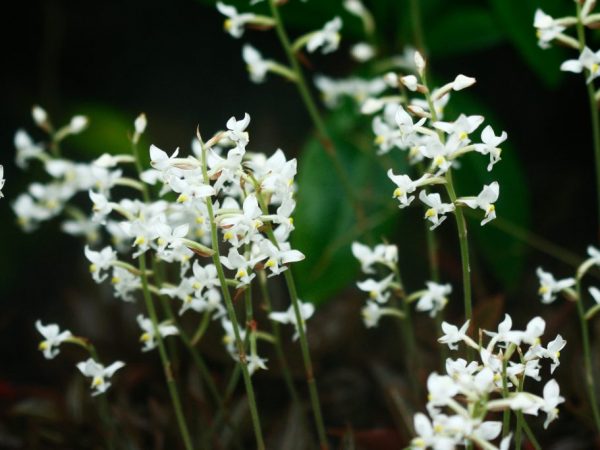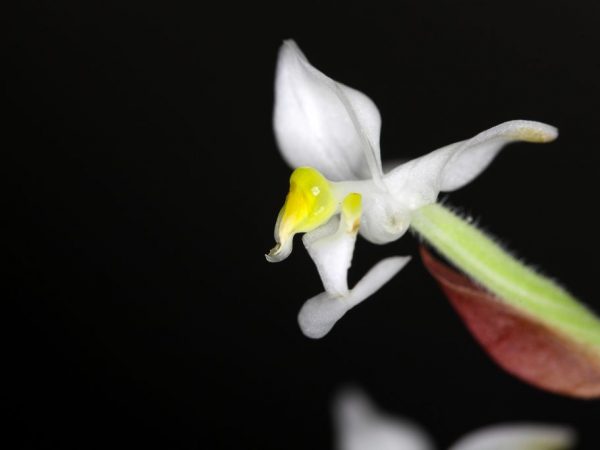Ludisia orchid care at home
Ludisia orchid is an unusual member of the orchid family with small flowers that look like precious pearls.

Ludisia orchid care at home
Biological characteristic
In natural conditions, ludisia is common in humid forests in the Asian east and central territory. Its growing places are the earth's surface and cave slopes covered with moss.
Other names for the flower are hemaria and precious ludisia.
Leaf Description:
- large, bright green, oval;
- length up to 7 cm, width up to 4 cm;
- folded into a socket of 4-5 pieces;
Ludisia orchids grow up to 15 cm, have an active ability to release side shoots. Covered with graceful flowers, located on peduncles 25 cm long. Buds are small, up to 2 cm in diameter, white. The inflorescence petals are rounded.
Views
Ludisia discolor orchid has varieties:
- Dawson is a large representative, growing up to 30cm. Has pink stripes on large foliage.
- Odin - stands out with silvery shading on the foliage.
- Alba - has light leaves with longitudinal white stripes.
- Tahlaniya - leaf blades are covered with a patterned mesh.
- Corduroy - longitudinal bright red stripes on a bright flower.
Care features
Caring for the ludisia orchid at home involves observing the basic rules for planting it, maintaining the microclimate during its growth, as well as processing against diseases and pests.
Conditions for landing
A suitable soil for planting ludisia orchids is a mixture of:
- 4 tsp chopped pine bark, taken together with pine needles,
- 4 tsp sphagnum moss,
- 1 tsp charcoal powder
- 1 tsp peat,
- 1 tsp sheet soil.
You can plant ludisia in a ready-made soil mixture intended for growing orchids. For planting ludisia, the pot should be small in size with wide drainage holes. But the bottom should be placed with a vermiculite mixture or brick chips.
When planting, the root system of the flower is placed in the upper layer of the soil mixture so as not to deepen the growth points.
A place
The preferred place for the growth of ludisia is the shade, however, indirect sunlight in the morning and evening will not interfere with it. Grows well in the northern part of the room. The flower is favorably affected by a long daylight hours, therefore, in winter it requires additional lighting.
Microclimate

The orchid does not tolerate heat
Microclimate for Ludisia:
- the flower must maintain a temperature of 20 ° -23 ° during the day and at least 17 ° -19 ° at night, while the coolness of the night provokes the orchid to bloom,
- the desired moisture level is maintained through regular watering throughout the calendar year, while moisture should not stagnate in a constantly wet soil mixture, for which excess liquid after watering is drained from the pan after half an hour.
In order to ensure the coolness of the night, the orchid is recommended to be placed on a warmed balcony in May-September, making sure that there are no drafts. As a way to create the required humidity, it is advisable to use artificial fountains and aquariums located next to the flower, as well as indoor air humidifiers.
Diseases and pests
Top dressing helps to ensure the resistance of ludisia against diseases and pests. They are made at the flowering stage, making complexes for growing orchids twice a month.
With the regular transplanting of ludisia into the renewed soil mixture, additional feeding outside the flowering stage is not required for the plant.
At the primary signs of the appearance of scale insects, aphids, mealybugs or whiteflies that infect orchids, I treat the plants with an insecticidal preparation.
Breeding order
Reproduction of the ludisia orchid occurs by the vegetative method. There are no restrictions on the reproduction period of the plant, because the orchid does not have well-defined rest periods.
Ludisia breeding process:
- The stems are cut into several stalks with 2-3 internodes using a garden tool.
- The ends for disinfection are treated with charcoal powder.
- The cuttings are planted in a mixture of pine bark with sphagnum moss, spreading them horizontally and pressing a little into the soil without sprinkling them with earth.
- The container with the planted cuttings is covered with polyethylene or glass to create a greenhouse effect.
Rooting of ludisia cuttings occurs after 2-4 weeks. In this case, young roots will be clearly traced from the edges of the cutting. At the first leaves that appear, the plant begins to be left without shelter, maintaining a high level of humidity. With the first appearance of peduncles on young sprouts, they are removed in order to ensure full growth and development of the root system.
Pruning and replanting
In the process of caring for ludisia, it is necessary to prune and transplant the plant.
Pruning
The shoots of ludisia that have elongated over time must be cut to give the plant an attractive appearance. They are cut directly near the root, the length is 4-5 cm.After pruning, the ludisia sprouts new shoots with dense foliage, as a result of which its crown will acquire a compact, lush appearance.
Transplant and division
Ludisia is transplanted as needed, about once every 3-4 years. In some cases, with the active growth of the bush, the transplant can be every 2-3 years.
The transplant procedure rejuvenates the flower and gives an impetus for its further growth.
To divide the ludisia bush, the plant is watered so that the soil mixture is damp, then the shoots with roots are divided into parts, trying not to tear the shallow root system. The resulting parts are planted in pots, trying to arrange their roots as they grew before dividing and transplanting.
Flowering ludisia
Ludisia blooms from November to January. Duration of flowering is 5 weeks. The plant will be able to ensure flowering if, when caring for it in the summer, the buds are prepared for laying. It is necessary to adhere to a constant temperature: during the day from 20 ° to 29 °. The nighttime temperature should differ from the daytime by 3-5 points. Such differences give an impetus to the flower for the formation of flower buds.
The constant coolness is capable of prolonging the home flowering of ludisia, when the air temperature is maintained at 18 ’.
During the flowering process of a plant, it is important to prevent water from getting on the peduncles during watering and to monitor the condition of the soil, which should not be either dry or excessively wet.
Conclusion
The precious Ludusia orchid has a beautiful appearance. Regardless of the variety, each ludisia requires careful maintenance. Provides long-term flowering and vigorous growth if growing rules are followed.


